
Vagrant Hummingbirds in and around NYC
All photos and text on this page are ©2001-2012 Phil Jeffrey. If you want to do more than just look at them on the web, please contact me.
Vagrant hummingbirds fascinate many of us, and over the last decade we've been fortunate to have been visited by several of these in and near New York City. This page - indeed this entire website - was first created when the immature male Rufous Hummingbird appeared at Lenoir in 2001, followed by NY State's first Calliope Hummingbird records that same winter in Manhattan. The vagrant hummingbird story caught the attention of CBS News in 2002.
NYC hummingbird vagrancy went through a quiet patch in 2006 to 2010 when there were apparently no reports, but in 2011 there were multiple reports of vagrant Selasphorus hummingbirds occurred throughout the northeast and 2012 appears to be a year with a lot of reports as well. Although Cornell's eBird data is notoriously incomplete, this Rufous Hummingbird eBird map gives you some sense of it (for 2011 - alter the parameters for other time periods). Of note in 2011 were Rufous Hummingbirds at Lenoir Preserve in Yonkers and at the Natural History Museum in Manhattan. In 2012 Selasphorus hummingbirds were seen at two locations in Manhattan, but access to the Fort Tryon one was hampered by post-storm cleanup.
Birds featured here:
Hummingbird ID is often difficult, and none more so than in vagrant hummingbirds because they are more often than not immatures, and more often than not the rather difficult Rufous/Allen's split. Rufous is far more likely than Allen's in the East, but this risks being a circular argument if we assume all Selasphorus hummingbirds found here are Rufous Hummingbirds (in 2012 there have been some Allen's reports). For many of these birds a definitive speciation is difficult unless we capture the bird (and not all of us think that it matters so much that we should stress the bird doing that). However the rapid expansion of bird photography has allowed us to get good looks at all of these birds to attempt to definitively ID them. I am biased toward this approach because I take a lot of bird photographs.
The two best USA hummingbird ID books are the ones by Steve Howell "Hummingbirds of North America" (AP Natural World series) and "A Field Guide to Hummingbirds of North America" (Peterson Field Guides) by Sheri Williamson. Not a bad idea to get both, if you are interested in hummingbird ID. Both books are excellent and overlap in discussion, but have different representations. Also there's a rather useful discussion of "rufous" hummingbird ID from the Louisiana Ornithological Society which also overlaps the discussion in the two books. Of course, for sheer immersion in the subject, nothing quite beats doing to south-east Arizona during hummingbird migration.
The ultimate fate of these vagrant birds is uncertain. There's some suspicion
that many of the succomb to the elements, but at least in the case of
Selasphorus hummingbirds enough banded vagrants have been recovered to
suggest that survival is not just a remote possibility. See, for example,
the Wintering Hummingbirds
page by Stacy Jon Peterson and in particular the pages for Rufous/Allen's
for 2003/4 and
2004/5. (As is the fate of many pages on the
web, this useful site has suffered its demise). Winter 2011/2012 was very mild and
therefore seems to have allowed several vagrant hummingbirds to survive the entire winter.
But on to the actual birds:
These pictures were from Dec 24th 2011 - immature plumage, pre-molt. The partial tail spread shot that confirms the ID of this bird as an immature female Rufous Hummingbird - separated from Allen's by the width of the outer retrices/tail feathers and separated from Broad-tailed by the extent of rufous color on R2 (retrix #2, second from center). Others had obtained tail-spread shots before me so I didn't discover anything new. Unlike some other hummingbirds this one had relatively little rufous on the back, being rather greenish. However the gorget actually contains some rufous coloration, and in some ways looks a little more like an adult female gorget than the relatively lightly-marked throats we see on many immature females. Hummingbirds can molt gorgets during the winter (the 2001 Yonkers male was clearly doing that) although molt may suspect if there's a lack of food. The tail pattern firmly establishes this bird as a first winter female, however. It's similar to the 2006 Lenoir Preserve Rufous in having quite a lot of color in the throat.
DNAinfo.com (Manhattan local news site) has a little piece on this bird, and there's been some coverage in the City Room at the NYTimes. This bird was also seen feeding in Central Park on Jan 10th 2012 - expanding its nectaring range to the Winterdale Arch near Tanner's Spring. Unfortunately that does involve crossing Central Park West, but these birds are fast and maneuverable. This is the latest-surviving/staying hummingbird of all the NYC/Yonkers hummingbirds that I've kept track of, an unprecedented survivor, helped by the warmest winter in recent memory and a lack of persistent snowfall.
An immature female Rufous Hummingbird at Lenoir Preserve in Yonkers, November 2011 of which I got adequate but not definitive photos of. I'm not sure who found this hummingbird but Lenoir is a regular fall location for western hummingbird vagrants. Others have obtained tail spread shots and this is yet another first winter immature female Rufous. It's quite remarkable just how many of the vagrant Rufous are immature females - I would have expected immature males to be the vanguards. I can find dates for this bird from Nov 6th - Dec 11th 2011. Those dates do not overlap the known one for the Manhattan bird but the appearence of the gorget on them is different - they are unlikely to be the same individuals.
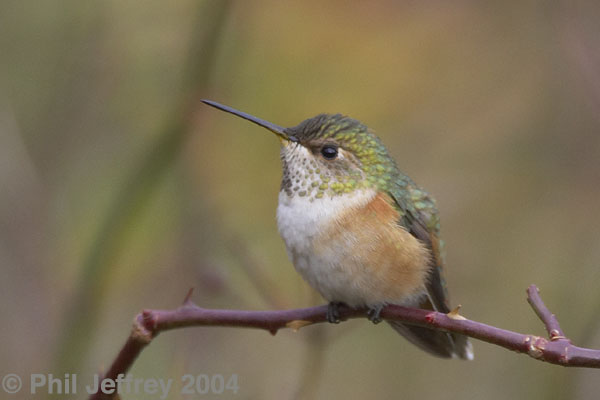
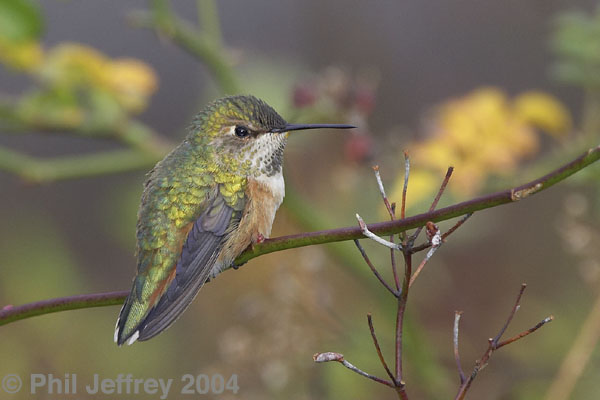
Based on the extent of the gorget feathers as a significant central spot (the feathers visible as rufous under favorable conditions), the absence of rufous gorget feathers elsewhere on the throat (they are green), the general lack of rufous on the back and head, and the lack of "rifling" pattern on the bill often seen in immature hummingbirds, this bird appears to be an adult female. Adults are much less common as vagrants than immatures, but adult females aren't a lot easier to ID than immatures (adult males are a lot easier). Statistically the bird is more likely to be Rufous than Allen's, something that is made even more likely by the relative broadness of the tail feathers in some of my own photos. However Cal Vornberger got a tail-spread shot of this bird which makes it's ID unequivocal - adult female Rufous Hummingbird. The pattern on the R2 feather is definitive and reliable in adult birds.
In bad light I took several photos of this bird on 12th November 2002:
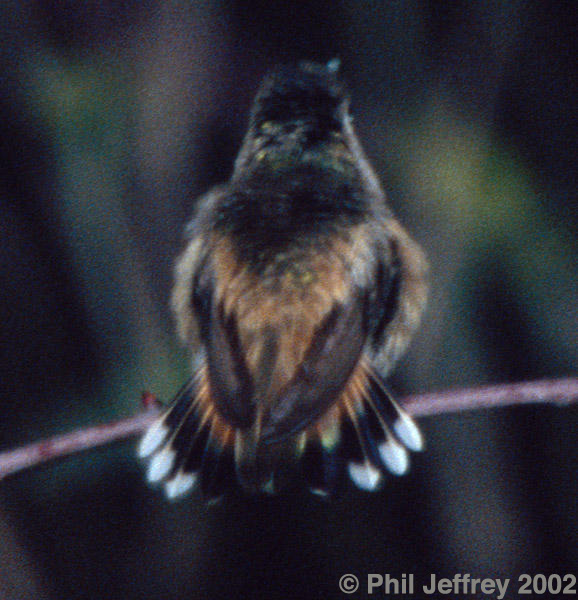
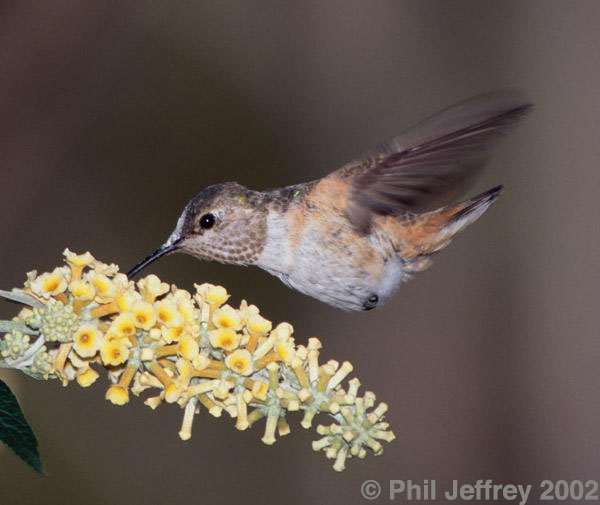
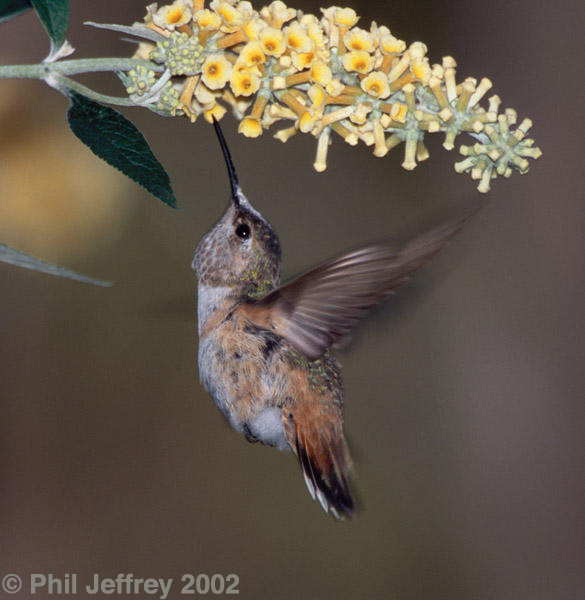
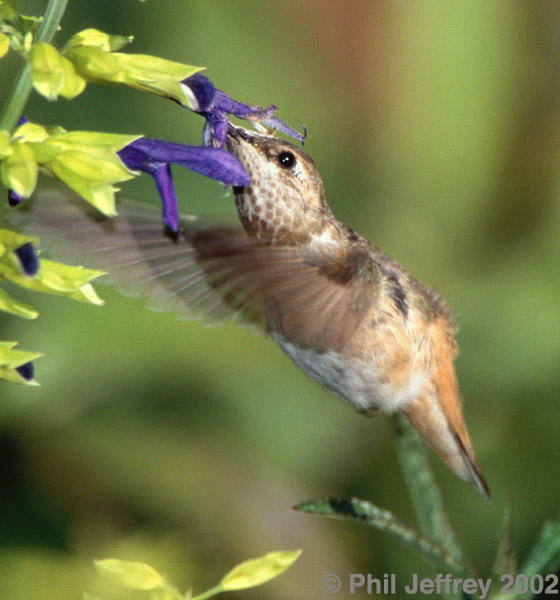
The first photo is a "tail spread" shot of dubious quality, but it does show that R5 (outermost) is smaller than R4 and R3, but the extent of which is up for debate. Unfortunately R2, although having a small white tip, is not well-defined in the photos. There is a suggestion that R2 may have a small notch on the inside, but it's just a suggestion. The other three photos are just feeding shots that help to show the extent of rufous in the upper tail coverts and back - there is not enough rufous in them to clinch Rufous over Allen's but the tail does show enough green in R1 to indicate immature female over immature male, which is consistent with the reasonably broad tail feathers. There's a fair amount of variability in these sort of markings but the lack of rufous on the rest of the bird also suggests a female. There is rather extensive green stippling in the gorget, but I can detect no rufous in those feathers in my photos. The extent of gorget markings give me some qualms about the identification of the bird as an immature female, but for now I will stick with the ID.
More recently (June 2003), Sheri Williamson of the Southeastern Arizona Bird Observatory made the comment that the narrowness and length of the retrices seemed much more suggestive of Allen's over Rufous. This opinion is shared by other experienced birders that have seen the photos. Although stopping short of absolute certainty, there seems a distinct likelyhood that the Central Park bird would constitute the first NY State record for Allen's Hummingbird. Getting it accepted by NYSARC is another matter, not least of all because it may be impractical to separate Allen's from Rufous with certainty short of capturing it (which is exactly what they did in the fall 2003 Cape May Allen's Hummingbird).
There are also pictures of this bird taken by Cal
Vornberger, also featuring a tail-spread shot.
The Central Park Allen's appears to have left around lunchtime on Saturday November 23 2002, a day of very high winds. (Hummingbirds migrate during the day). Another Selasphorus was seen in Manhattan that day, down at Wagner Park, but I don't think it was the same bird.
There's a disturbing possibility that the rarity of Allen's Hummingbird in the east is partially a product of expectancy - i.e. many Selasphorus are assumed to be Rufous because that is assumed to be the far commoner species based on the distribution maps and migration patterns. I personally didn't see any photos of the 2002 Lenoir Selasphorus that were definitive for Rufous over Allen's, although quite obviously comparsion of the morphology of the Central Park and Lenoir birds might tell us something. In fall of 2011 in the course of going through the identification of the AMNH Rufous I took another look at the tail spread shot I had and it became much more obvious to be that the bird was an Allen's Hummingbird based on the narrowness of the outer retrices. Despite the fact that NYSARC has not formally considered this bird (and also that I don't consider my ID's beholden to the NYSARC stamp of approval) I've relabeled this as a definitive Allen's.
As of Nov 20th 2002 there were apparently TWO hummingbirds at Yonkers, but the second one was not refound subsequently.
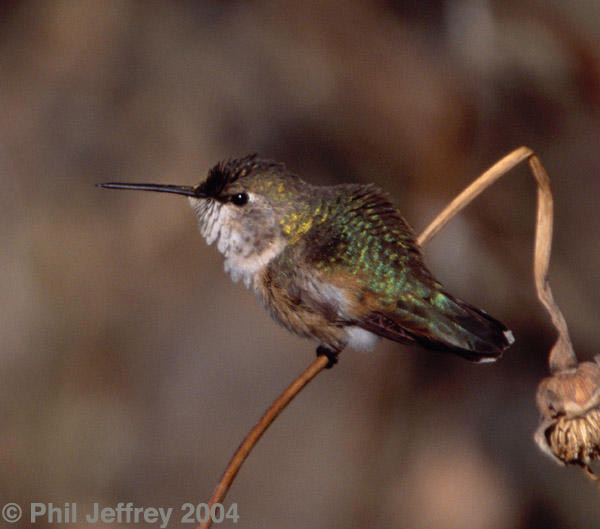
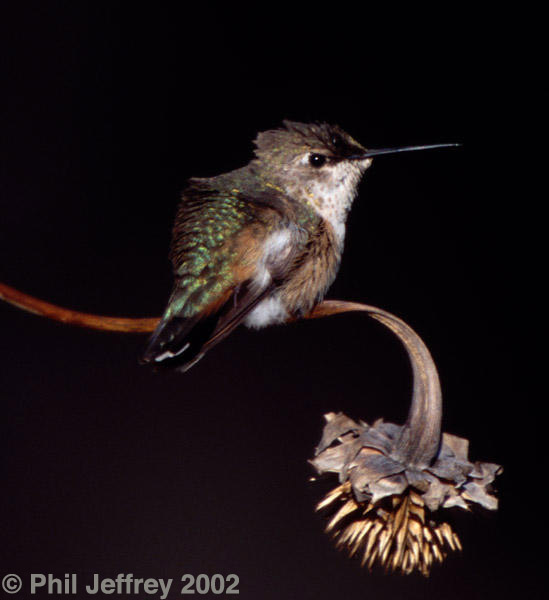
This bird was present from October 28th 2002 to November 29th 2002.
The short tail (including rufous coloration) and in particular the two elongated gorget feathers on the right of the bird unequivocally confirm Ben's initial ID. An exceptional find in a little-birded part of Manhattan. Here are three pictures of it:
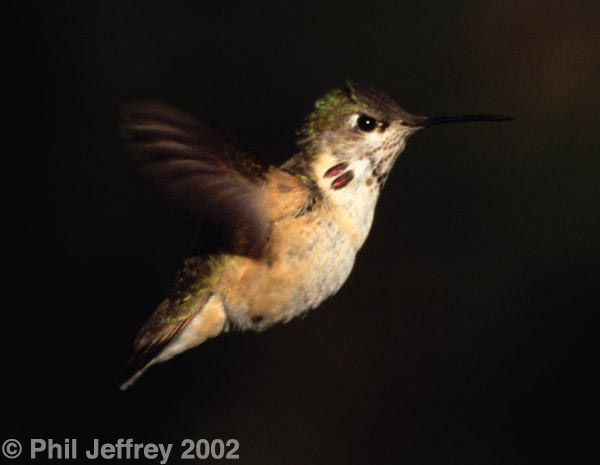
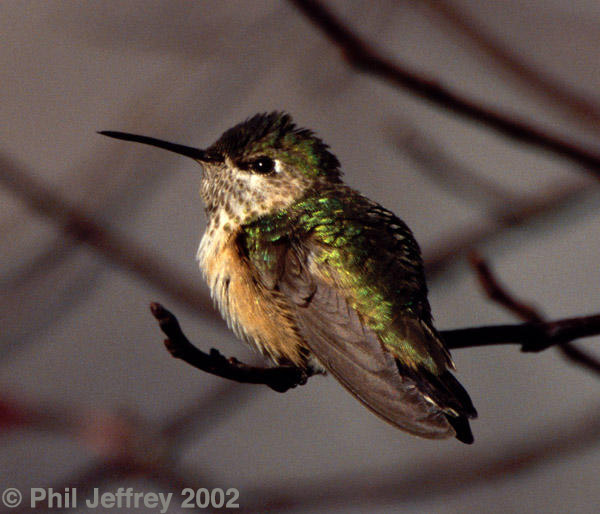
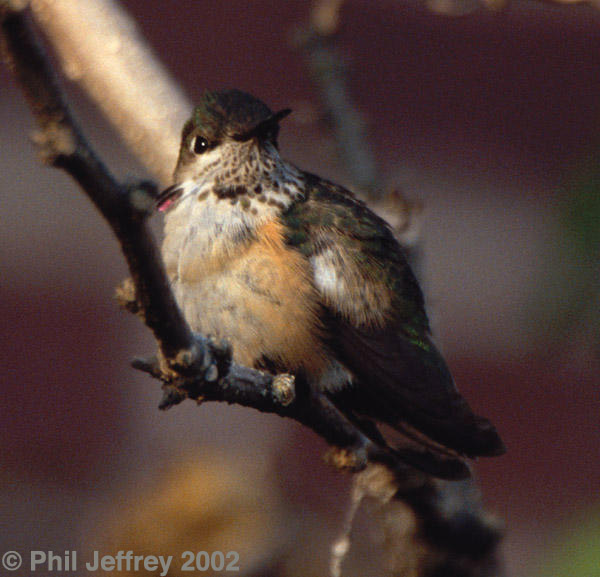
The Calliope may have left in the first part of the week of Thanksgiving (~Nov 25th 2002). There was a female Calliope found in NJ (Atlantic County) at the beginning of November 2002, and another Calliope found near Philadelphia in late November 2002 (the first for PA).
Latterly a second hummingbird turned up at this location on Saturday Nov 23rd. Although initially ID'd as a second Calliope, it seems reasonably certain that this is a Rufous/Allen's Hummingbird based on markings (extent of rufous, plus head pattern) and structure (tail length). More than one observer had noted that the few gorget feathers appear to be rose/wine red. This mark would appear to be at odds with Rufous/Allen's Hummingbird but is perhaps just an anomaly. I did get an opportunity to take a quick couple of pictures of this bird, albeit of very average quality:
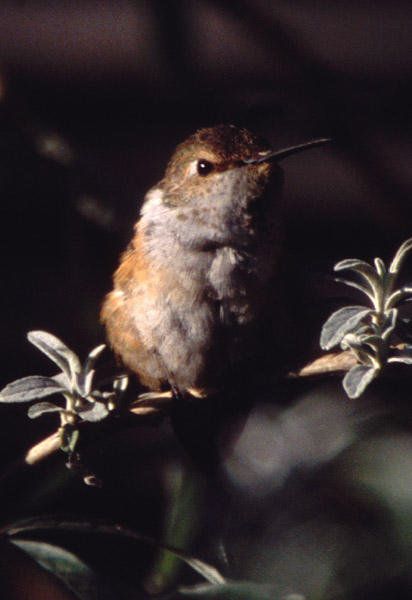
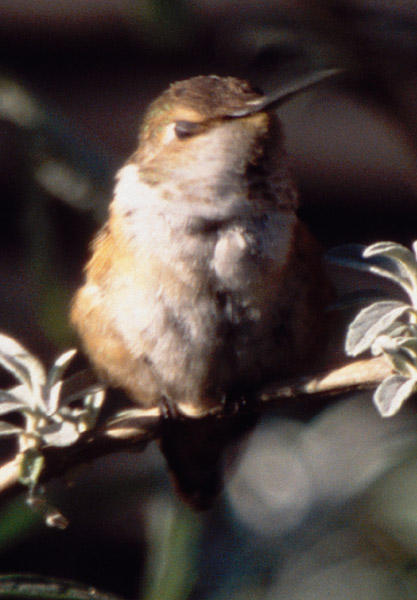
First of all, it's apparent that there is rufous coloration on the crown and face of this bird. It's even more evident in the original slides. This eliminates Calliope immediately and suggests an immature Rufous/Allen's. The gorget, however, doesn't show much in the way of colored feathers in this photo. Either way, the gorget appears different to the Central Park bird, and the presence of rufous crown feathers is also different. This is yet another Selasphorus hummingbird and not the Central Park bird. The second picture, albeit blurred, shows more clearly the tail being somewhat pointed (probably eliminating Broad-tailed) and also helps further eliminate Calliope which would show a blunter tail/wing combination. Reports that the gorget feathers are red are at odds with the ID (Rufous/Allen's might be expected to be rufous, Broad-tailed would be red), but these are not shown in my photos. Paul Lehman commented that the straight line demarcation between the crown and face color between the eye and the bill indicated Rufous/Allen's over Calliope and Broad-tailed. Since there's a fair amount of rufous on it I'm tempted to call it an immature male, but that's really just a guess.
Kevin McGowan has posted a good discussion of the ID issues between Rufous and Allen's hummingbird including pictures of the Lenoir Rufous. Michael Bochnik, the first birder to see the Rufous, also has a discussion page.
Sadly, I don't think anyone has ever obtained really good photos of the notch on the next-to-middle tail feather (retrix R2) although there are a few suggestive photos I've seen, plus more than enough observations to leave the ID in little doubt. The best tail picture I've got is:
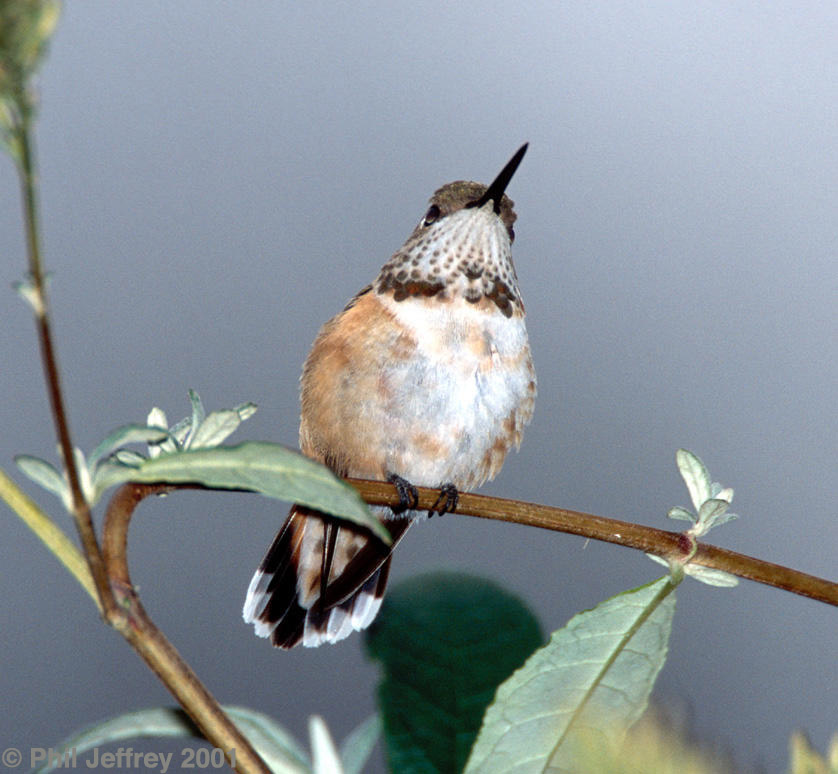
This clearly shows the relative width of the outer retrices (R5 vs R4), another partial diagnostic for the Rufous/Allen's split. If you look hard at R2 you can see that it is relatively pointed, with what appears to be cutouts on both inside and outside. The other two photos are more for esthetic purposes, although if you look at the back feathers in conjunction with the Louisiana Ornithological Society article on Selasphorus Hummingbird ID you'll see that they are also suggestive of Rufous. The emerging gorget on the bird points clearly to immature male. (The gorget is the last thing to moult in on an immature hummingbird).
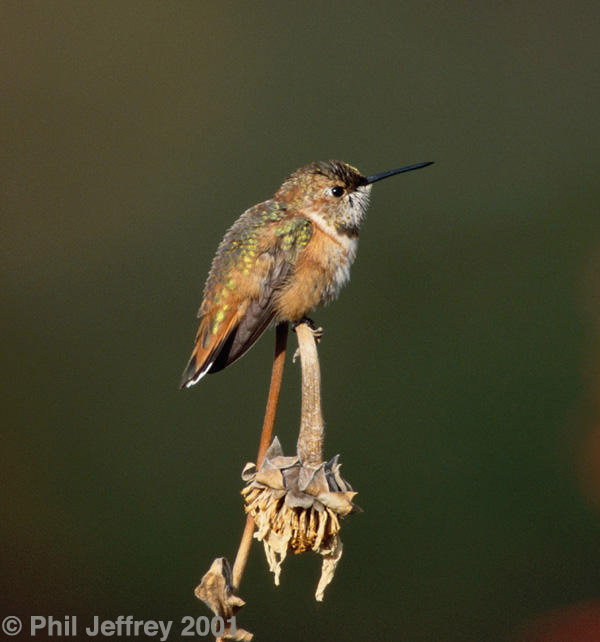
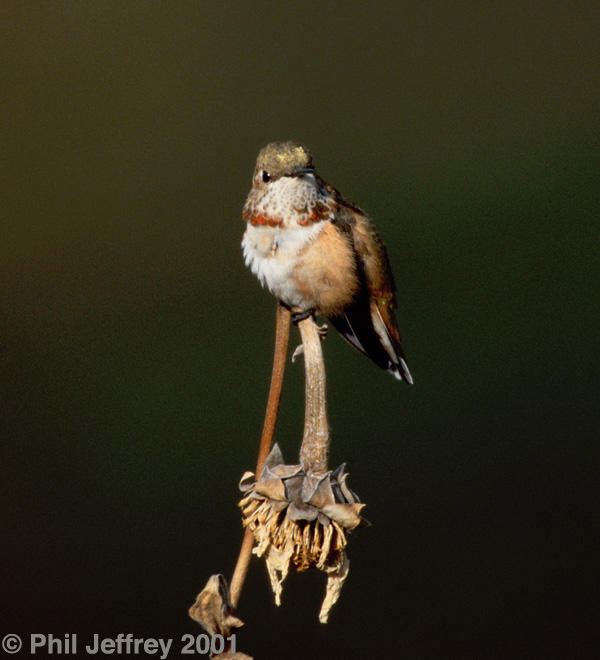
There are also pictures of this same bird at the
Linnaean Society website by Mike Stubblefield (long-since vanished).
It's pretty difficult to be definitive about immature vagrant Rufous/Allen's in the field, but the ID marks that are present lean more toward Rufous than they do Allen's, and I'm reasonably comfortable with that identification.
At the time of discovery (late Nov 2001), Rufous Hummingbirds were also present at Barnegat NJ and Cape May NJ. Another Selasphorus hummingbird made a brief appearance in Central Park towards the end of December 2001, but apparently did not linger. The Lenoir/Yonkers bird became more rufous as the weeks progressed, with a slightly more extensive gorget (the last part of the bird to undergo moult to adult plumage). The bird persisted as of Jan 5th 2002, despite occasional freezing weather up in Yonkers, but vanished soon afterward.
Along with Mike Stubblefield and Ben Cacace, I saw this bird on December 15th in the early afternoon. It perched low in the Pineapple Sage, and was present even while the Rufous was around. In general however when the Rufous became aware of the Archilochus' presence, the Rufous chased it away (Rufous are notoriously belligerent). This bird conspicuously avoided the feeder, feeding exclusively upon the Pineapple Sage, and doing so infrequently. It probably didn't help that the sage was starting to die at that point. Food choices were extremely limited.
We did get a few looks of the bird perched, and there was some disagreement amongst us as to how thick the wings appeared. Although the ID is not exactly trivial, the bird seemed a little more consistent with Black-chinned than with Ruby-throated based on the shape of the outermost primaries. The bird did not exhibit significant tail-pumping when feeding, however. I still remain somewhat ambivalent as to the ID of this particular hummingbird, especially on the grounds of plumage, but I went out of my way from winter 2002 to fall 2003 to observe the tail "flickering" effect in Ruby-throated and feel comfortable asserting that the Lenoir bird was in the range for Ruby-throated. I've seen Black-chinned since fall 2002 and they often show a lot of tail bobbing, but memory fades so cannot be definitive on the comparison Here is one picture I have of the bird, in profile:
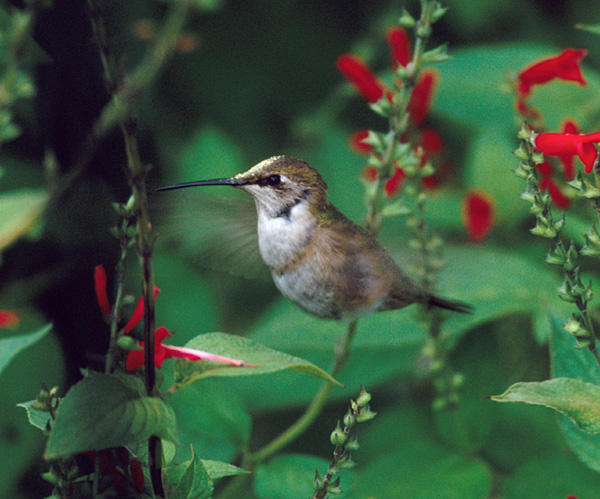
and it really is a fat hummingbird, which gives some hope for its survival. The primary profile shot cited in the article(s) is mine, but it's of unexceptional quality. Black-chinned would be a new NY state record.
Subsequently there were two articles in vol. 53 of the Kingbird and both are available online. I find both articles (by Mike Stubblefield and Andy Guthrie respectively) unsatisfactory because they both fail to acknowledge that there are features in this bird that taken in isolation might indicate either species. There are statements in both articles that are really very questionable (Guthrie's assertions about the photographic effects on primary shape; tail bobbing in Stubblefield's article) from my perspective. The things that point toward Ruby-throated are both morphology and color: the length of the bill, the extension of the green color up into the nape and rear crown. The thing that points toward Black-chinned is the apparently broad profile to the tip of primary P10. There are lot of ambiguous and ill-characterised points on this bird (e.g. the particular hue of the back; the relative projection of the wings to the tail). There seems to be a certain amount of creative reasoning in both articles in order to justify a whole list of criteria as being "consistent" with one species or the other. The simple fact is that there are a lot of ID marks that are consistent with both species but this doesn't prove anything. The most definitive mark (shape of P10) was not seen/photographed well, there's enough reasonable evidence that this bird could be a Ruby-throated Hummingbird and not strong evidence that it could not be a Ruby-throated Hummingbird. Therefore, and particularly influenced by the tail-bobbing behavior in my case, I call this bird a Ruby-throated Hummingbird, while acknowledging a certain amount of ambiguity in the ID. We will never know beyond question the ID of this bird.
One of the remarkable things about these birds is just how cooperative they were - they perched up literally 20 feet away from the observer, displayed and squabbled with each other at similar distances, and seemed generally oblivious to the amount of excitement they caused. The Salvia on which they spent some time feeding is ceased flowering around the first cold snap of late December 2001, and the birds vanished shortly before the New Year 2002 (Dec 27th 2001). Hummingbirds seem to provoke an emotional response in many birders, including myself, and many of us still cling to the hope/delusion that they survived.
Some of the earliest pictures of these birds were by Michael Bochnik. Subsquently many people have got photos of these birds, given their cooperative nature. Here are four of mine:
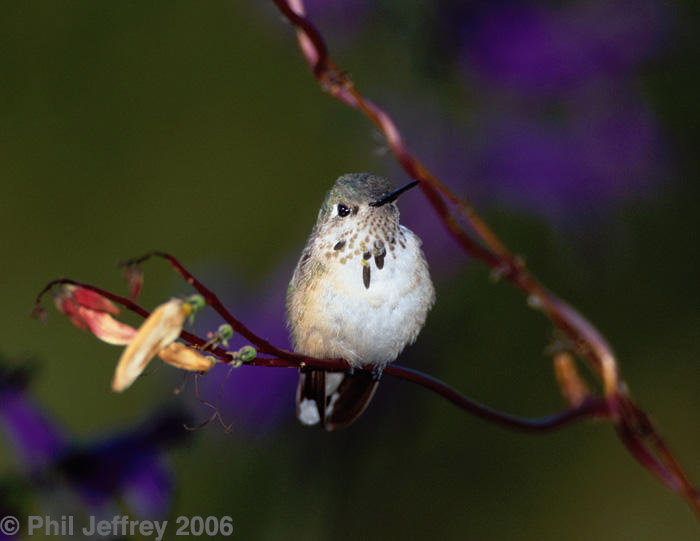
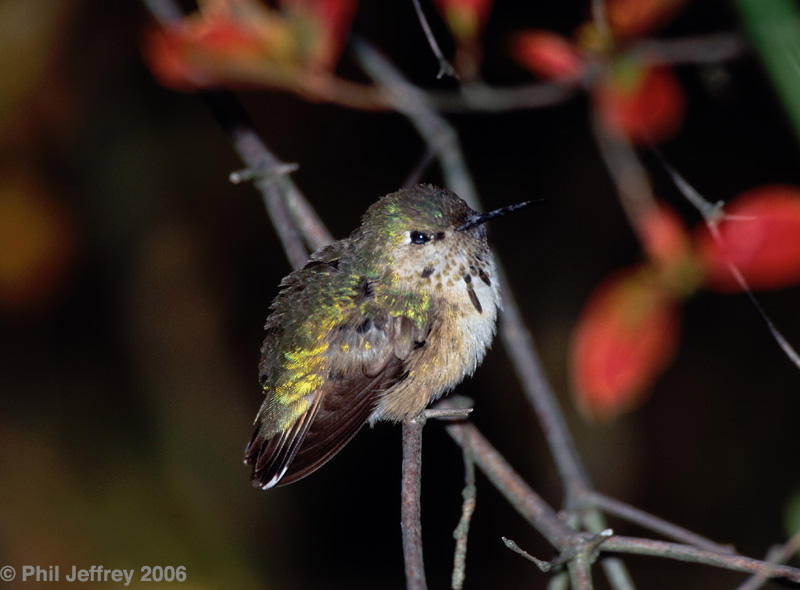
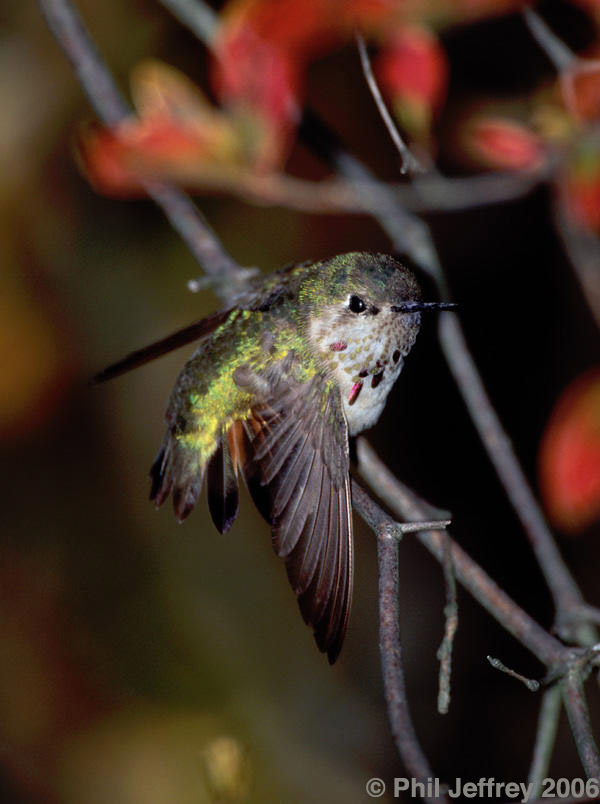
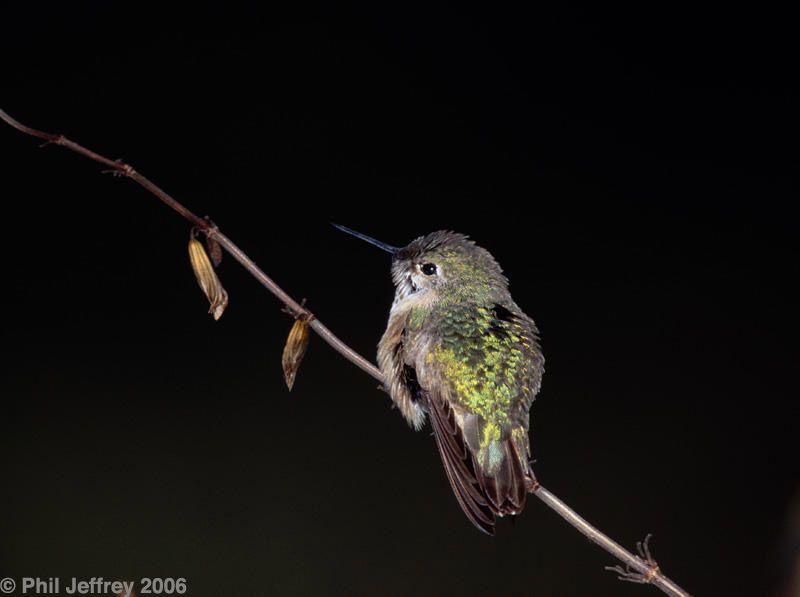
Also:
NY Times article on the Calliopes (you will have to register in order to
read it, but it's free).
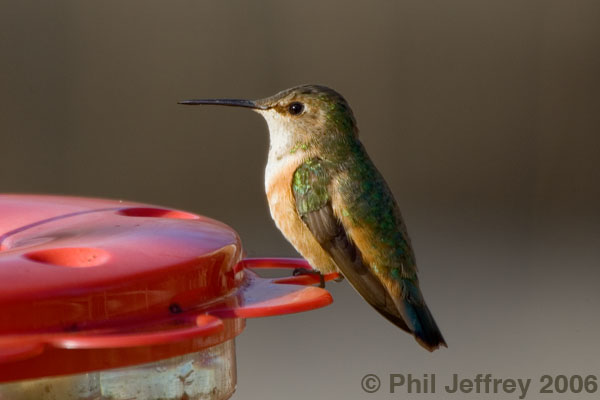
There's a significant significant central spot (you can't see it on this photo) which did not irridesce as rufous in my presence. The back is mainly greenish with no significant numbers of rufous feathers. It's clearly not an adult male. The lack of more extensive rufous tends to eliminate immature male. The central spot is less typical for immature female, but compared to the Central Park adult female there's much less dark coloration in the throat. This appears on balance to be an immature female, although the central spot leads some to think adult female (see this link for photos by Shane Blodgett, who leant in that direction). In fact this gorget spot was quite similar to the 2011 AMNH Rufous. Steve Walter got a good shot of the spread tail of this bird ( see here), which shows some wear - sheer broadness of the retrices are more immature-like and the shape and color of the feathers is unambiguous for first winter immature Rufous. The lack of indentation on R2 doesn't exactly prove it's Rufous over Allen's - but the average width of the outermost retrices leans toward Rufous, however. This bird was apparently present from Nov 23rd 2006 through January 6th 2007.